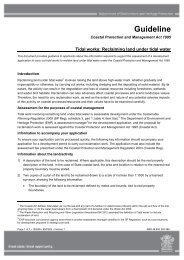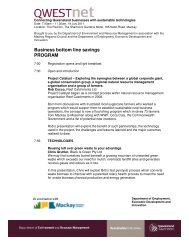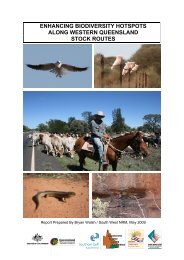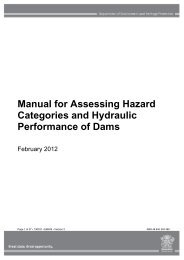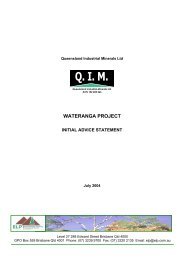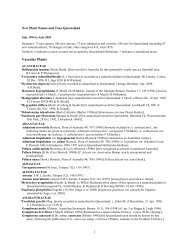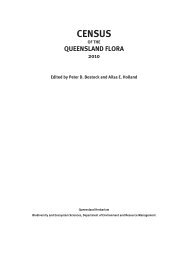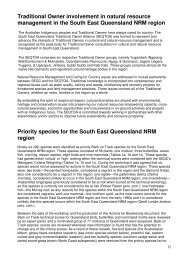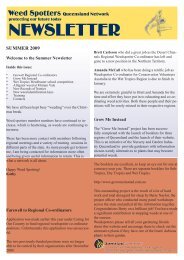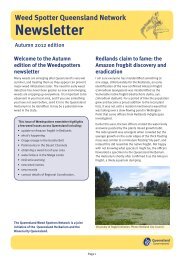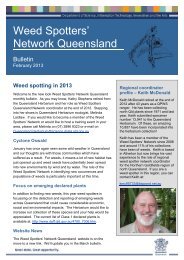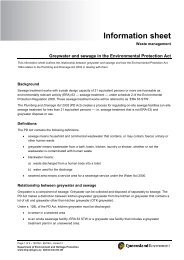Distribution, abundance and biology of Group V humpback whales ...
Distribution, abundance and biology of Group V humpback whales ...
Distribution, abundance and biology of Group V humpback whales ...
Create successful ePaper yourself
Turn your PDF publications into a flip-book with our unique Google optimized e-Paper software.
The main calving ground <strong>of</strong> the east Australian <strong>humpback</strong><br />
whale stock is defi ned to the north by the Whitsunday<br />
Isl<strong>and</strong>s (Chaloupka <strong>and</strong> Osmond 1999). Simmons <strong>and</strong><br />
Marsh (1985) reported that calves tend to be seen north <strong>of</strong><br />
the latitude 21°S early in the migration during the months <strong>of</strong><br />
June <strong>and</strong> July.<br />
Since 1993, the Pacifi c Whale Foundation has undertaken a<br />
mark-recapture study using photo-identifi cation techniques.<br />
Their study (Pacifi c Whale Foundation 1997) describes the<br />
distribution <strong>of</strong> mother-calf pairs as being in the sheltered<br />
waters both around <strong>and</strong> inshore <strong>of</strong> the Whitsunday isl<strong>and</strong><br />
group. However, the <strong>whales</strong> are widely dispersed with no<br />
obvious pockets <strong>of</strong> concentration. They also conclude that<br />
<strong>whales</strong> do not appear to be staying in the region for any<br />
great length <strong>of</strong> time, except for mother-calf pairs.<br />
Malcom <strong>and</strong> Duggan (1997) undertook aerial survey <strong>of</strong><br />
the Whitsunday Isl<strong>and</strong>s to determine the distribution <strong>and</strong><br />
<strong>abundance</strong> <strong>of</strong> <strong>humpback</strong> <strong>whales</strong>. They concluded that most<br />
<strong>of</strong> the <strong>whales</strong> were observed south <strong>of</strong> Hook <strong>and</strong> East Black<br />
Reef, an area were there is likely to be less disturbance <strong>of</strong><br />
<strong>whales</strong> because it is south <strong>of</strong> the main vessel transit route.<br />
However, it is uncertain if this is an artefact <strong>of</strong> the small<br />
sample size.<br />
4.4.4 Cairns region<br />
Anecdotal information suggests that the numbers <strong>of</strong><br />
<strong>humpback</strong>s are increasing in the inshore waters <strong>of</strong> the<br />
Cairns region.<br />
4.4.5 Hervey Bay Marine Park<br />
Hervey Bay (latitude 25°S) is a large shallow embayment<br />
<strong>of</strong> approximately 4000 square kilometres, bound to the<br />
west by the mainl<strong>and</strong> <strong>and</strong> by Fraser Isl<strong>and</strong> to the east.<br />
Most <strong>of</strong> the Bay is less than 18m deep <strong>and</strong> has a s<strong>and</strong> or<br />
mud fl oor. Fraser Isl<strong>and</strong>, the world’s largest s<strong>and</strong> isl<strong>and</strong>, is<br />
126 kilometres long. The isl<strong>and</strong> extends north <strong>and</strong> south<br />
bridging the continental shelf. Smith (1997) produced a<br />
comprehensive summary <strong>of</strong> the research undertaken <strong>and</strong><br />
management <strong>of</strong> Hervey Bay Marine Park.<br />
Based on aerial <strong>and</strong> boat-based studies, <strong>humpback</strong>s<br />
have been found to favour the eastern part <strong>of</strong> Hervey Bay,<br />
especially Platypus Bay, <strong>and</strong> tend to aggregate in shallow<br />
water close to the western coast <strong>of</strong> Fraser Isl<strong>and</strong> (Corkeron<br />
et al.1994; Pacifi c Whale Foundation 1993; The Oceania<br />
Project 1999). The area <strong>of</strong>fshore from the Wathumba Creek<br />
is identifi ed as being an area that is favoured by <strong>humpback</strong>s<br />
(Corkeron et al.1994; The Oceania Project 1999). It is<br />
uncertain what contributes to this aggregation but it could be<br />
the freshwater infl uence <strong>of</strong> the creek.<br />
Humpbacks have been recorded in Hervey Bay during the<br />
months <strong>of</strong> July–November (The Oceania Project 1999;<br />
Pacifi c Whales Foundation 2001). Temporal procession<br />
<strong>of</strong> <strong>whales</strong> entering the bay is similar to that described for<br />
the whole <strong>Group</strong> V population (Chittleborough 1965 <strong>and</strong><br />
Dawbin 1966). Immature <strong>humpback</strong>s enter the Bay fi rst in<br />
late July <strong>and</strong> mothers <strong>and</strong> calves in September, but there<br />
is no data indicating that the Bay is <strong>of</strong> importance to any<br />
particular age-class <strong>of</strong> the <strong>Group</strong> V population (Corkeron et<br />
al.1994). However, the use <strong>of</strong> the Bay by mothers <strong>and</strong> calves<br />
in September is coincident with school holidays <strong>and</strong> an<br />
associated increase in recreational boating activity.<br />
8 • <strong>Distribution</strong>, <strong>abundance</strong> <strong>and</strong> <strong>biology</strong> <strong>of</strong> <strong>Group</strong> V <strong>humpback</strong> <strong>whales</strong> Megaptera novaeangliae: A review • August 2002<br />
Bryden <strong>and</strong> Corkeron (1989) estimated that approximately<br />
30 percent <strong>of</strong> the <strong>Group</strong> V population enters Hervey<br />
Bay each year. Corkeron et al.(1994) concluded that the<br />
similarity between the proportion <strong>of</strong> calves observed in<br />
Hervey Bay <strong>and</strong> the estimates <strong>of</strong> the rate <strong>of</strong> increase for the<br />
<strong>Group</strong> V population suggests that females with calves do not<br />
preferentially use the Bay. During September <strong>and</strong> October,<br />
mother/calf pods move through the Bay in waves or pulses<br />
<strong>and</strong> <strong>of</strong>ten stay for prolonged periods.<br />
There are no published sightings <strong>of</strong> newborn calves in<br />
Hervey Bay. Rather than being described as a winter<br />
ground, Hervey Bay is considered a resting site for<br />
<strong>humpback</strong>s migrating south to Antarctica. There is no<br />
information to suggest that commercial whale watching has<br />
or has not altered the distribution <strong>of</strong> <strong>whales</strong> in Hervey Bay.<br />
The pre-whaling distribution is unknown for this localised<br />
area.



